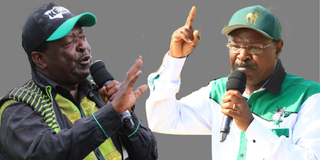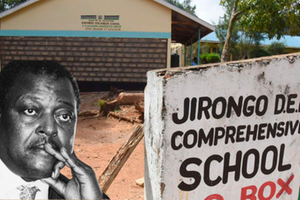Premium
Sibling rivalry: Mudavadi, Wetang’ula fight for third in command

Amani National Congress party leader Musalia Mudavadi and National Assembly Speaker Moses Wetang'ula.
In one of the most discrete political plots ahead of this year’s elections, President Uhuru Kenyatta’s handlers first identified Amani National Congress (ANC) party leader Musalia Mudavadi as his preferred successor.
Midway through the execution of their scheme in 2019, however, they shifted attention to Orange Democratic Movement (ODM) leader Raila Odinga because he best suited their interests.
David Murathe, the outgoing President’s close ally and one of the transition schemers, says the initial decision to back the ANC leader as heir to the throne was persuaded by his political experience and national stature.
Mudavadi was further adjudged favourably as a comprise candidate who enjoyed political chemistry and a long-standing relationship with Kenyatta.
In their assessment, though, Mudavadi’s “Mr Nice” outlook and his gentlemanly political mien were not enough to crack the quandary at hand, which was to stop Kenyatta’s deputy William Samoei Ruto from ascending to the presidency.
Behind-the-scenes manoeuvres opted for Odinga, a seasoned politician and four-time presidential contender, whom Murathe says “was solidly grounded and therefore the only one capable of stopping Ruto”.
In retrospection, Murathe may well have been correct about Mudavadi when he pointed out that he was “incapable of stopping Ruto”. This is because he actually just succeeded in doing the opposite – enabling a Ruto presidency.
Alongside his Ford-Kenya counterpart, Moses Wetang’ula, who was recently elected Speaker of the National Assembly, Mudavadi is basking in the glory of scorning Kenyatta’s plea to support Odinga’s candidature.
In a highly dramatised protest move, dubbed “Earthquake”, Mudavadi instead threw his support behind Ruto. Today, he peers into his political future and that of his western Kenya backyard with hope.
With the election of Wetang’ula as Speaker and his own nomination as Prime Cabinet Secretary on the cards, the excitement among voters in western Kenya is understandable.
While Mudavadi and Wetang’ula secured less votes for Kenya Kwanza in the region than Odinga’s (besides bagging fewer elective seats in the gubernatorial and parliamentary races), Ruto’s ultimate victory is a most welcome development for the two.
It has catapulted them to senior national positions and given them a great opportunity to charm the ground to their side.
Exciting battle ahead
Under the emerging circumstances, a political battle with Odinga is inevitable.
As ODM’s deputy party leader, immediate former Kakamega Governor Wycliffe Oparanya is primarily the custodian of the Odinga support base in the region and will put up a spirited fight to guard what he worked so hard to achieve.
Besides securing 10 out of 12 parliamentary seats for Azimio in Kakamega County, Oparanya, who spearheaded the coalition’s campaign in the region, also ensured a resounding victory in Busia, and in Mudavadi’s home county of Vihiga, where Azimio won the gubernatorial and senatorial slots. Going forward, these are gains that Mudavadi and Wetang’ula will want to wrestle from Oparanya, and by extension Odinga, which makes for an exciting political battle ahead.
But perhaps the most vicious and less talked about the battle is going to come from right within – between the two “political brothers”.
Henry Wabwire, a commentator on political affairs, argues that Mudavadi and Wetang’ula cannot be Ruto’s joint pointmen in the region as well as joint leaders of the Luhya nation, or joint presidential candidates in the next elections.
“At the risk of being accused of wedging a rift between them, I have to mention it plainly that the two will naturally clash in their pursuit for political influence and repositioning ahead of the next General Election. It is just the nature of politics,” opines Wabwire.
Already, Wetang’ula and Mudavadi separately consider themselves as “third in command” in political influence and power after President Ruto and DP Rigathi Gachagua. Internal political competition is one great hurdle that the two leaders will have to overcome if they are to avoid the same pitfalls as their predecessors.
Unlike the neighbouring Luo community, or the Kikuyu and Kalenjin, who ordinarily rally their support behind one leader at a time, Luhya politics has over the years been characterised by intense rivalry between leaders from the community.
In 2002, for instance, when President Daniel arap Moi of the then ruling Kanu party appointed Mudavadi as the vice-president – the first from the community – he received strong opposition from Michael Kijana Wamalwa of Ford-Kenya. Wamalwa went ahead to vanquish Mudavadi and Kenyatta at the ballot to become the eighth VP.
Wamalwa passed on in August 2003, and although President Mwai Kibaki replaced him with another Luhya – Moody Awori – the move was resisted by leaders from present-day Bungoma and Trans Nzoia counties.
Musikari Kombo, who replaced Wamalwa as Ford-Kenya party boss, led protests to Kibaki, saying they wanted a new VP appointed from either of the two counties and from the Ford-Kenya fraternity. Awori, from Busia County, was then allied to Odinga’s Liberal Democratic Party.
The disagreements are reminiscent of the political supremacy battles witnessed in the 1970s and 1980s between ex-Cabinet minister in the Jomo Kenyatta government Masinde Muliro and Musalia’s father, Moses Mudavadi, who was a powerful Local Government minister in Moi’s government.
The stars of other influential politicians of the time, including Butere MP Martin Shikuku and his Kimilili counterpart, Elijah Mwangale, similarly failed to shine on the national stage.
Shikuku, for instance, vied for the presidency in 1997 under the Ford-Asili party, garnering a paltry 36,302 votes that represented 0.60 per cent of the votes cast.
Campaign pledges
Their numbers notwithstanding, Wabwire surmises that the political leaders of the Luhya – the second largest community after the Kikuyu – have over the decades lacked unity and coordinated focus.
While, for instance, the senior Mudavadi is credited for fostering development, including securing employment for residents from the region, Muliro focused more on political unity as a means of securing power.
Wabwire, nonetheless, hails the long-standing cordial relations witnessed between Mudavadi and Wetang’ula.
The two Kenya Kwanza principals now shoulder the political dream of most western Kenya residents, who are fixated with the notion of occupying the country’s top seat. While all Luhya political players agree that one of the two should rise to the helm of the country’s leadership, the avenue of realising this goal remains a major source of debate and disagreement.
Wetang’ula, for instance, holds that locals must first “politically free themselves” from Odinga’s stranglehold, which explains his decision late last year to defect from the defunct National Super Alliance to team up with Ruto.
The next step, according to him, is to win over the ODM leader’s supporters in the region before seeking backing from other Kenyans.
But Oparanya considers such an approach simplistic and a product of siege mentality. The former governor believes the region can only make an impact on the national stage by teaming up with neighbouring communities under the old “Kavirondo” arrangement, and not through the exclusion of other communities.
As the Mudavadi-Wetang’ula pair settles down in the new political dispensation under Ruto, observers and pundits will be on the alert, monitoring how they balance between executing their campaign pledges and manoeuvering their way on the political chessboard towards the coveted prize in 2027, and beyond.




